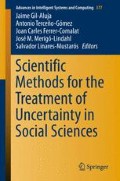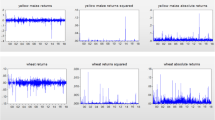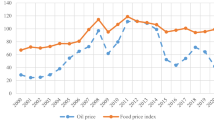Abstract
The past decade has witnessed the entry of speculative investors as major participants in commodity markets. This phennomenon arises the question of whether these agents influence price dynamics or not. Therefore, the aim of this paper is to explore evidence in order to determine if commodities have behaved in a similar manner to financial assets. This study will focus specifically in the maize market, analyzing the extent to which financial market variables influence price movements. By means of an autoregressive vector system (VAR) the effect of interest rate changes on maize futures prices will be tested. Implications for countries heavily reliant on commodity exports will be drawn from the results of this study.
Similar content being viewed by others
Keywords
1 Introduction
Grain prices have been very volatile in recent years. They reached a peak in 2008 and then decline sharply, and started to raise in 2010. In particular, in 2011, maize price exceeded the level of June 2008 (UN 2011).
Volatility in grain prices is due to several causes, but can be simplify in two mayor correlated factors: market and weather. Climate factors cause traditional uncertainty in grain prices, affecting quantities. Because they are highly unpredictable and have a direct incidence on stocks, they constitute a major source of price uncertainty in the future. On the other hand, market effects are related to the functioning of the market itself: number of producers, productivity, price formation process, speculation, substitution effects, financial effects, etc.
In this particular work, we will focus in one specific financial effect: the commodities financialization process. The purpose of this is to collect evidence to prove that the increase in price volatility is due to actions of new financial investors and not because of traditional market or climate effects.
The major problem of the process is that these participants may add a new kind of uncertainty to the market, making it more complex and volatile. The consequences can be deep, especially on countries dependent on grain exports. Though, studying the financial effects on grain prices can provide more information in order to reduce uncertainty.
In the first section of this work we define the concept of commodities financialization. In the second section, we test one financialization hypothesis for the case of the international maize price: using a vector autoregressive model (VAR) we test the incidence of the interest rate over the maize price during 1990–2014. In the last section, we present some conclusions related to the incidence of this process not only in investment strategies buy mostly in countries dependent on commodities exports.
2 Commodities Financialization
During the last years, financial innovations allowed agricultural commodities to become part of portfolio investments. This means that financial investors began to buy these products, having no relation with production or even the commercialization of them. As any financial investment, the objective is to speculate with higher prices in a future horizon.
The process through which these products became part of portfolios of financial investments is called commodities financialization.
According to Tang and Xiong (2010), the presence of large investment funds makes that these markets behave more as a financial market rather than a commodities one. Henderson et al. (2012) defines the process as the relative influence gained by the financial sector in comparison with the real sector in order to determine price levels and daily returns of these markets.
This process was possible through one financial innovation: the Exchange-Traded Funds (ETF’s). The ETF’s are basically investment funds that replicate the behavior of a certain index, such as a commodity index. The main feature of these funds is that their shares are traded in real time as any other stock, being able to be bought or sold at any time.
Investment in commodity index had an exponential growth during the last years. According to Tang and Xiong (2010), these vehicles try to replicate the return of certain portfolio, including a wide variety of products. However, in all cases the financial engineering is based on long positions on future markets, without possession of the real product. For a deep analysis of the phenomenon see United Nations (2011).
The main question that arises is if the presence of these funds has change commodities price formation process. If they follow traditional investment strategies, the interest rate become a significant variable. Thus, if there is a financialization process, commodities prices might be more sensitive to changes in the interest rate. To test that hypothesis, in the next section we test the influence of the interest rate over the maize price. It is important to mention that Rondinone and Thomasz (2015) have found a strong relation during the last years for the case of soybean.
3 The Interest Rate Incidence Over the Maize Price
In order to test the incidence of the interest rate over the maize price we use a vector autoregressive model (VAR).
We select this tool among other options, such as simultaneous equations, because it allows the study of impulse-response functions. These functions analyze the model dynamics, showing the response of the explicative variables. A shock in one variable will affect itself and at the same time will propagate to the rest of the variable through the dynamic structure of the VAR model. To expand about the model see Sims (1980). For information about lags criteria selection, see Ivanov and Kilian (2005).
We use a Bivariate VAR model presented by Urbisaia (2000):
The corresponding structural model is:
The vectorial notation of the model is:
Considering the stationarity of the VAR (1) it can be written as moving average vector \( \left( \infty \right) \):
Combining the previous representation with the structural model,
This representation allows an interaction analysis between series. The coefficients \( \phi_{ik} \) can be used to generate the effects of \( \mu_{1t} \) y \( \mu_{2t} \) over the trajectories of \( Y_{1t} \) and \( Y_{2t} \). These coefficients are the multipliers of the system and their graphic representation constitute impulse-response functions. This functions will be used to test the incidence of the interest rate over the maize price.
3.1 VAR Model
The chosen variables are the American treasury bills interest rate, the dollar exchange rate and the stock/consumption relation of the maize:
Pmaize represents the maize international price, taken from the future contracts of Chicago Market. These are nominated in dollars per ton (U$/tn) and the information source is the International Monetary Fund.
Tasa is the American interest rate and is represented by the 10 year´s treasury bills of constant maturity. The information source is the Fed of St. Louis.
Dollarindex represents an index that measures the relative valuation of the dollar against a basket of foreign currencies. Such basket is composed as follows: 57.6 % Euro, 13.6 % Yen, 11.9 % Sterling, 11.9 % Canadian Dollar, 9.1 % Swedish Krona and 3.6 % Swiss franc. The information source is the electronic trading platform DTN PropheteX.
Stockcons represents the relation stock/consumption of maize in USA. The information source is United States Department of Agriculture (USDA).
The variables are monthly from 1990 to 2014. The tests were performed using Eviews.
3.2 Testing and Results
The methodology is the following: first, the time horizon is divided into two periods: 1990–2003 and 2004–2014. Within each period we perform the following test: first the unit root test on the variables, as to select to use level or first difference in order to gain stability. Then, co-integration test among variables, as to determine if it is possible to use a truly independent VAR model. Then, we perform a stability test to the VAR model itself. If stable, the impulse-response functions are constructed generating a shock of inters rate and a shock of stocks. The tests and figures one to six were performed using Eviews software.
3.3 Period 1990–2003
The unit root test on all the variables on level does not reject the null hypothesis. Meanwhile, the first difference of every series, does not present unit root (Table 1).
There is no relation among variables according to the co-integration test, so it is possible to apply a VAR model.
Stability test results stays that all roots are less than one, so the VAR is stable (Fig. 1).
All independence and stability conditions are assure, so we proceed to test the response of the maize price given a shock of interest rate of one standard deviation (Fig. 2).
The impact during the period 1990–2003 matches the theory prediction: it generates a price declination.
If we apply a shock of stocks we obtain the same result (as expected): an increase of stocks generates a price declination (Fig. 3).
3.4 Period 2004–2014
The unit root test on all the variables on level does not reject the null hypothesis. Meanwhile, the first difference of every series, does not present unit root (Table 2).
There are not relations among variables according to the co-integration test, so it is possible to apply a VAR model (Fig. 4).
Stability test results stays that all roots are less than one, so the VAR is stable. All independence and stability conditions are assure, so we proceed to test the response of the maize price given a shock of interest rate of one standard deviation.
Again, a positive shock of interest rate generates a price declination. Moreover, during this period the effect is deeper than the previous one. Nevertheless, the effect disappears after the fifth period (Fig. 5).
In the case of a shock of stocks, the result again shoes a declination of price (Fig. 6).
4 Conclusions
Testing results are showing that in both periods the interest rate has an effect in the maize price. Nevertheless, the effect is much deeper during 2004–2014. During this period the Commodities Index Funds (in the form of Exchangeable Trade Funds) exhibited a fast growing pace. Thus, the fact that during the period in which many commodities were part of portfolio investment the relation between price and interest rate was stronger, may add more evidence to the commodities financialization hypothesis, in this case particularly to maize. Rondinone and Thomasz (2015) achieved similar results in the case of soybean, although with stronger effects.
We can resume the following consequences. First, the financialization process implies that the incorporation of commodities into a financial portfolio will not diversify risk as it did in the past. Second, at a macro level, changes in the international interest rate will affect not only the capital account of the balance of payments but also the trade balance. This will specially affect countries heavily reliant on commodity exports, and can reinforce the amplification effect of external shocks, as described by Thomasz and Caspari (2010).
References
Aulerich, N.M., Irwin, S.H., Garcia, P.: The price impact of index funds in commodity futures markets: evidence from the CFTC’s daily large trader reporting system. Working Paper (2010)
Basu, P., Gavin, W.T.: What explains the growth in commodity derivatives? Fed. Bank of St. Louis Rev. 93(1), 37–48 (2010)
Gilbert, C.L.: The impact of exchange rates and developing country debt on commodity prices. Econ. J. 99, 773–784 (1989)
Gilbert, C.L.: How to understand high food prices. J. Agric. Econ. 61(2), 398–425 (2010)
Henderson, B.J., Pearson, N.D., Wang, L.: New evidence on the financialization of commodity markets. Working Paper, George Washington University (2012)
Ivanov, V., Kilian, L.: A practitioner’s guide to lag order selection for VAR impulse response analysis. Stud. Nonlinear Dyn. Econometr. 9(1) (2005)
Sims, C.A.: Macroeconomics and reality. Econometrica 48, 1–48 (1980)
Sorrentino, A., Thomasz, E.: Incidencia del complejo sojero: implicancias en el riesgo macroeconómico. Revista de Investigación en Modelos Financieros 3(1)1, 9–34 (2014)
Tang, K., Xiong, W.: Index investment and financialization of commodities. Fin. Anal. J. 68(2), 54–74 (2010)
Thomasz, E., Casparri, M.: Chaotic dynamics and macroeconomics shock amplification. Comput. Intell. Bus. Econ. 507–515 (2010)
United Nations: Price Formation in Financialized Commodity Markets: The Role of Information. United Nations, New York (2011)
Urbisaia, H., Brufman, J.: Análisis de series de tiempo: univariadas y multivariadas. Cooperativas, Buenos Aires (2001)
Yang, J., Bessler, D.A., Leatham, D.J.: Asset storability and price discovery in commodity futures markets: a new look. J. Futur. Markets 21(3), 279–300 (2001)
Author information
Authors and Affiliations
Corresponding author
Editor information
Editors and Affiliations
Rights and permissions
Copyright information
© 2015 Springer International Publishing Switzerland
About this paper
Cite this paper
Casparri, MT., Otto-Thomasz, E., Rondinone, G. (2015). The Commodities Financialization As a New Source of Uncertainty: The Case of the Incidence of the Interest Rate Over the Maize Price During 1990–2014. In: Gil-Aluja, J., Terceño-Gómez, A., Ferrer-Comalat, J., Merigó-Lindahl, J., Linares-Mustarós, S. (eds) Scientific Methods for the Treatment of Uncertainty in Social Sciences. Advances in Intelligent Systems and Computing, vol 377. Springer, Cham. https://doi.org/10.1007/978-3-319-19704-3_25
Download citation
DOI: https://doi.org/10.1007/978-3-319-19704-3_25
Published:
Publisher Name: Springer, Cham
Print ISBN: 978-3-319-19703-6
Online ISBN: 978-3-319-19704-3
eBook Packages: EngineeringEngineering (R0)










